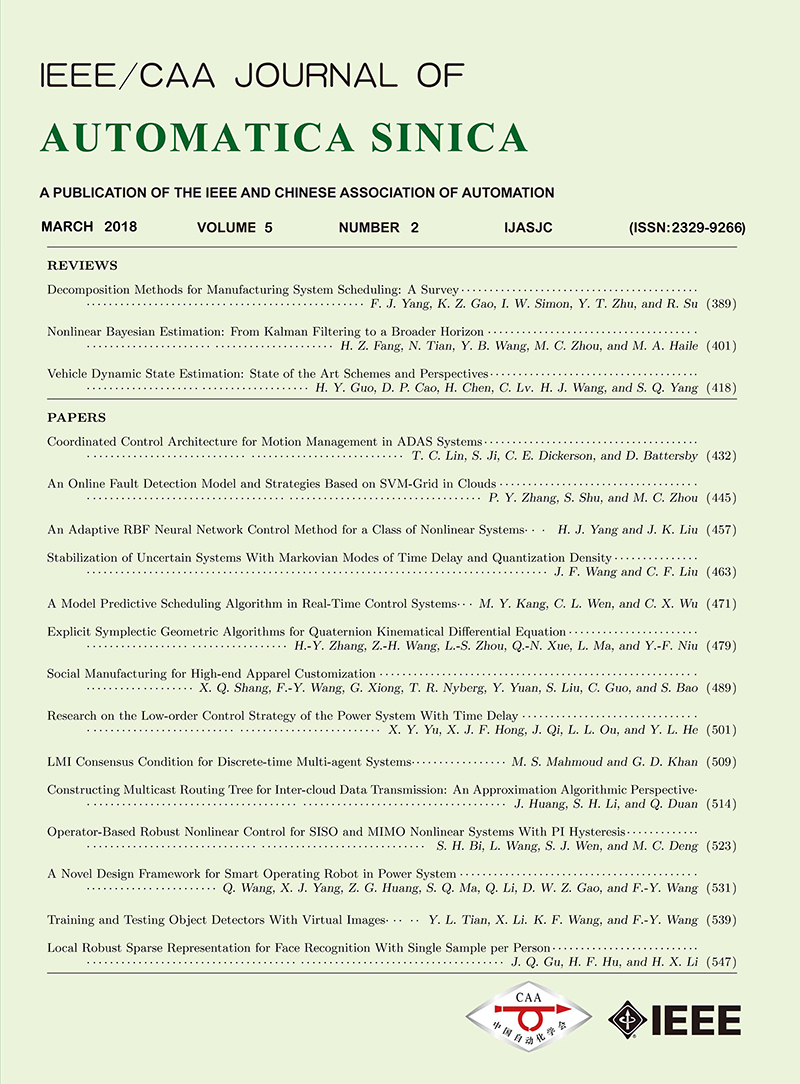 Volume 5
Issue 2
Volume 5
Issue 2
IEEE/CAA Journal of Automatica Sinica
| Citation: | Feng Jin, Jun Zhao, Chunyang Sheng and Wei Wang, "Causality Diagram-based Scheduling Approach for Blast Furnace Gas System," IEEE/CAA J. Autom. Sinica, vol. 5, no. 2, pp. 587-594, Mar. 2018. doi: 10.1109/JAS.2017.7510715 |

| [1] |
J. Zhao, W. Wang, K. Sun, and Y. Liu, "A Bayesian networks structure learning and reasoning-based byproduct gas scheduling in steel industry, " IEEE Trans. Automat. Sci. Eng. vol. 11, no. 4, pp. 1149-1154, Oct. 2014. http://ieeexplore.ieee.org/document/6588622/
|
| [2] |
X. P. Zhang, J. Zhao, W. Wang, L. Q. Cong, and W. M. Feng, "An optimal method for prediction and adjustment on byproduct gas holder in steel industry, " Expert Syst. Appl., vol. 38, no. 4, pp. 4588-4599, Apr. 2011. http://www.sciencedirect.com/science/article/pii/s0957417410010894
|
| [3] |
J. Zhao, Q. L. Liu, W. Wang, W. Pedrycz, and L. Q. Cong, "Hybrid neural prediction and optimized adjustment for coke oven gas system in steel industry, " IEEE Trans. Neural Netw. Learn. Syst. , vol. 23, no. 3, pp. 439-450, Mar. 2012. http://ieeexplore.ieee.org/document/6126048/
|
| [4] |
H. N. Kong, E. S. Qi, S. G. He, and G. Li, "MILP model for plant-wide optimal by-product gas scheduling in iron and steel industry, " J. Iron Steel Res. Int., vol. 17, no. 7, pp. 34-37, Jul. 2010. http://www.wanfangdata.com.cn/details/detail.do?_type=perio&id=gtyjxb-e201007007
|
| [5] |
H. Ru, F. Gao, Y. F. Xu, and X. H. Guan, "Online strategy for scheduling by-product gas supply, " in Proc. 2013 IEEE International Conference on Information and Automation (ICIA), Yinchuan, China, pp. 1246-1251. http://ieeexplore.ieee.org/document/6720485/
|
| [6] |
J. C. Bezdek, Pattern Recognition with Fuzzy Objective Function Algorithms. New York, USA:Plenum Press, 1981.
|
| [7] |
J. Zhao, Z. Y. Han, W. Pedrycz, and W. Wang, "Granular model of long-term prediction for energy system in steel industry, " IEEE Trans. Cybern. , vol. 46, no. 2, pp. 388-400, Feb. 2016. http://www.ncbi.nlm.nih.gov/pubmed/26168454
|
| [8] |
H. B. Cao, H. W. Deng, and Y. P. Wang, "Segmentation of M-FISH images for improved classification of chromosomes with an adaptive fuzzy C-means clustering algorithm, " IEEE Trans. Fuzzy Syst. , vol. 20, no. 1, pp. 1-8, Feb. 2012. http://ieeexplore.ieee.org/document/5872671/
|
| [9] |
X. Y. Tang, J. Zhao, C. Y. Sheng, and W. Wang, "Long term prediction for generation amount of Converter gas based on steelmaking production status estimation, " in Proc. 2014 IEEE International Conference on Fuzzy Systems (FUZZ-IEEE), Beijing, China, pp. 1088-1095. http://ieeexplore.ieee.org/document/6891775/
|
| [10] |
J. Pearl, Causality:Models, Reasoning, and Inference. Cambridge, UK:MIT Press, 2000.
|
| [11] |
M. Erwig, and E. Walkingshaw, "Causal reasoning with neuron diagrams, " in Proc. 2010 IEEE Symposium on Visual Languages and Human-Centric Computing (VL/HCC), Leganes, Philippines, 2010, pp. 101-108. http://ieeexplore.ieee.org/xpl/articleDetails.jsp?arnumber=5635201&filter%3DAND(p_IS_Number%3A5635184)
|
| [12] |
F. Thoemmes and K. Mohan, "Graphical representation of missing data problems, " Struct. Equat. Model., vol. 22, no. 4, pp. 631-642, 2015. doi: 10.1080/10705511.2014.937378
|
| [13] |
K. Mohan and J. Pearl, "Graphical models for recovering probabilistic and causal queries from missing data, " in Proc. 27th International Conference on Neural Information Processing Systems, Montreal, Canada, 2014, pp. 1520-1528. http://www.researchgate.net/publication/288688497_Graphical_models_for_recovering_probabilistic_and_causal_queries_from_missing_data
|
| [14] |
H. H. Dai, S. Keble-Johnston, and M. Gan, "Reliable knowledge discovery with a minimal causal model inducer, " in Proc. 2012 IEEE 12th International Conference on Data Mining Workshops (ICDMW), Brussels, Belgium, pp. 629-634. http://dl.acm.org/citation.cfm?id=2472970
|
| [15] |
F. M. Chen and D. Zhang, "Combining a causal effect criterion for evaluation of facial attractiveness models, " Neurocomputing, vol. 177, pp. 98-109, Feb. 2016. http://www.sciencedirect.com/science/article/pii/S0925231215016641
|